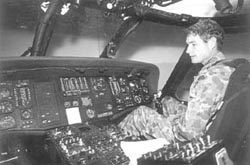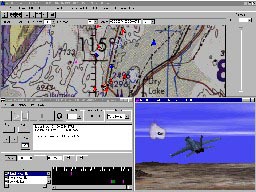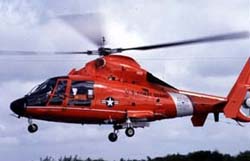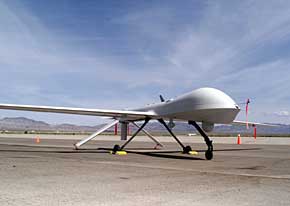Daily News
by Gail Helmer
[ Send Us News | Archives ]
Ubi Soft has sent us 5 new screenshots for Lock On: Modern Air Combat. Lock ON: Modern Air Combat combines a broad scope of game play that includes a dynamic battle generator, an immersive combat environment, robust multi-player options, and in-your-face action. Players will feel at home in the cockpit of these world-class fighters and they can easily jump into authentic combat action. Each aircraft is rendered in exceptional detail and performs just like its real world counterpart. Players can choose from eight U.S. and Russian jets that range from tank killing A-10 Warthogs and ground- pounding Su-25 Frogfoots to air superiority fighters like the F-15C Eagle and the Su-27 Flanker. Release Date: Q1, 2002.
SH2 and Destroyer Command Update
Ubi Soft has announced that they have pushed back the release dates for Silent Hunter II and Destroyer Command. Silent Hunter II has moved to October 30th 2001 and Destroyer Command has moved to Mid December 2001. The release says, "The reason behind this move is that Ubi Soft is so determined to make sure that both of these titles deliver the high quality that is expected by the simulation consumers. We are committed to releasing the best World War II Naval Simulations this Fall. We also feel that the additional development time now allotted to these titles underlines our continuing commitment to the Strategy / Simulation Genre."
Northrop Grumman Corporation's Integrated Systems Sector (ISS) has been awarded a contract from the US Navy's Naval Surface Warfare Centre-Dahlgren Division to develop an airborne mine detection system for the US Marine Corps.
The Coastal Battlefield Reconnaissance and Analysis (COBRA) programme, which includes a multispectral payload flown on a tactical unmanned aerial vehicle (UAV), will provide amphibious forces with accurate battlefield intelligence depicting tactical objectives, minefields, obstacles and fortifications on the beach and inland areas. The Northrop Grumman design will build on the successful COBRA Advanced Technology Demonstration programme completed by the Navy's Coastal Systems Station in the late 1990's. COBRA - Concept Movie
This passive sensor surveillance uses complementary technology to Northrop Grumman's Airborne Laser Mine Detection System work and positions Northrop Grumman for future combined sensor integration.
The total contract award could be valued at more than $44.7 million, if all options are exercised.
"Northrop Grumman's COBRA team brings together leading mine countermeasures experts in spectral imaging systems to design, build, test, deliver and support a 'best value' mine detection system for the war fighter," according to John Casko, Airborne Ground Surveillance & Battle Management (AGS&BM) Systems Advanced Mine Countermeasures director. "Our design......can be fielded on a variety of UAV platforms and provides expeditionary operations the ability to more effectively detect minefields in the beach and inland."
The AGS&BM Systems unit in Melbourne will manage Northrop Grumman's work under the COBRA contract. In addition, the Air Combat Systems unit in El Segundo, Calif., will manage the unmanned systems component.
The Northrop Grumman COBRA team also includes Arete Associates, Science & Engineering Associates, Wescam, General Dynamics-Advanced Technology Systems, PAR Government Systems and L3 Communications.
Simulator A High-Flying Success
The Australian Army is currently fine-tuning a world-first technology that has the capacity to significantly change training delivery for Black Hawk pilots. In a purpose-built facility at the Army Aviation Centre at Oakey, Queensland, staff are testing a simulator that will offer safe and effective training and experience to army pilots.
Project Manager Maj. Brett Corcoran said the Black Hawk simulator would be one of the most advanced helicopter training devices in the world. "This will be the first military helicopter simulator in the world to be accredited to Level D standard as laid down by the USA's Federal Aviation Authority," he said. "This means the simulator will achieve the highest level of training fidelity and flight-handling characteristics."

The simulator includes a full six-degree-of-freedom motion system, vibration platform and 220 by 60 degree field-of-view and chin-window monitors to give full night and day simulated flight. An Interactive Tactical Environment and Mission System (ITEMS) package is included in the simulator training system.
"This enables us to develop multi-aircraft missions and air, sea and ground scenarios - we can control every aspect of the aircraft's performance and its environment. "We can make use of more than 350 possible malfunctions to enhance emergency training and we can have the vehicle engaged by anything from a single infantryman with a rifle to a ZSU-23-4 anti-aircraft system."
One of the benefits of the system is the capacity to practice extremely dangerous maneuvers in complete safely - for example, a pilot can encounter catastrophic engine failure in flight without being in physical danger.
Project Test Pilot Maj. Edward Choice said the acquisition of the simulator represented a significant increase in training capability for the Army. "This is far in advance of any other synthetic training device the Army has used to teach its people how to do their business," he said. "With that comes an incredible responsibility to develop a suitable training system that meets and stretches the capability this machine can provide us. "This is an incredible opportunity and that's what our corps needs to get excited about right now."
Test and evaluation of the simulator will continue until early 2002.
On The Urban Battlefield Virtual Reality Is Not A Game
Canadian defence researchers will now be able to test the effectiveness of new technology for the soldier on the urban battlefield before committing to costly manufacturing.
The Canadian Defence and Civil Institute of Environmental Medicine (DCIEM), which is the lead laboratory for the Soldier Information Requirements (SIREQ) Technology Demonstration project that is the front-end R&D effort supporting Canada's soldier modernisation programme, has bought the ModIOS Tool Suite to be incorporated into the Dismounted Soldier Simulator (DSS), a virtual reality simulator. This is the third Canadian Defence agency to use ModIOS tool suite produced by Motorola's Integrated Information Systems Group and the first to deploy the DSS technology.

ModIOS is a complete combat training simulation management, visualisation and after-action-review software tool suite, which will be integrated into the DSS. This will enable DCIEM to prototype new soldier technologies via virtual reality. The DSS will be used in research and development efforts to explore the utility of new and existing technological enhancements for the urban battlefield using simulation that will assist in measuring the effectiveness of the technology.
The DSS will feature technologies, such as moving map displays, heads-up displays and fused sensors, which will be virtually prototyped and tested by Canadian Army soldiers during the performance of attack, defence, patrolling, and operations-other-than-war-type missions.
The visualisation function runs through the ModIOS Stealth Viewer to present a real-time, three-dimensional representation of the urban area. ModIOS will also be used for exercise control and after-action review, which provides an easy mechanism to record, playback, debrief and analyse simulation data and events distributed over a simulation network. The stand up DSS consists of three high-end personal computer workstations with graphic cards that provide a visual channel to drive a helmet-mounted display.
The DCIEM programme is a collaboration with Oerlikon Aerospace, a Canadian systems integrator. "Oerlikon Aerospace and DCIEM's innovative use of Motorola's ModIOS for virtual-reality prototyping demonstrates the versatility of the tool suite originally designed for military simulation," said Manny Mora, vice president of Motorola's Integrated Systems Division.
USCG Awards BLR Contract For Helicopter Strakes
The United States Coast Guard (USCG) has awarded Boundary Layer Research (BLR) a contract to adapt a NASA patented technology for use on their fleet of HH-65 Dolphin helicopters. The device, known as the BLR Tailboom Strake Modification is based on technology created at NASA's Langley Research Centre and is known to improve helicopter control characteristics.

The USCG hopes the device will help expand yaw control safety margins and reduce pilot workload for the HH-65 helicopter. If the strake device proves effective, it may become part of a USCG helicopter refurbishment program.
The programme is planned for three phases to be carried out over the next twelve months. Flight testing of the device on the HH-65 helicopter will take place at the USCG Aircraft Repair and Supply Centre sometime in autumn 2001.
Working with BLR on the project as subcontractors will be V/STOL Technology, Ltd and Raymond W. Prouty Consulting.
BLR licensed the strake technology patents in 1998 through NASA's Technology Transfer Programme and since then has refined the design, and adapted the technology for use on various civil and military helicopter models.
Error, Malfunction Cause Predator Accident
Officials investigating the March 30 crash of an RQ-1L Predator unmanned aerial vehicle have determined the accident resulted from operator error. The Accident Investigation Board report released Aug. 16 by Air Combat Command said the Predator experienced an icing problem and the pilot was unable to maintain control of the aircraft.

The Predator, which belonged to the 11th Reconnaissance Squadron at Nellis Air Force Base, Nev., was supporting the Kosovo Stabilization Force. There were no injuries or fatalities, but the Predator was destroyed upon impact.
The pilot recognized the icing problem, the report said, but failed to immediately execute critical checklist steps for pitot static system failure.
The pitot static system uses air and static pressure to determine the aircraft's altitude and airspeed. There is also substantial evidence that nonuse of the pitot static heating system was a substantially contributing factor in this mishap.
[ Send Us News | Archives ]
by Gail Helmer
Friday August 17, 2001
- New LOMAC Screenshots
- SH2 and Destroyer Command Update
- Northrop Grumman Awarded COBRA Contract
- Simulator A High-Flying Success
- On The Urban Battlefield Virtual Reality Is Not A Game
- USCG Awards BLR Contract For Helicopter Strakes
- Error, Malfunction Cause Predator Accident
PC News
New LOMAC ScreenshotsUbi Soft has sent us 5 new screenshots for Lock On: Modern Air Combat. Lock ON: Modern Air Combat combines a broad scope of game play that includes a dynamic battle generator, an immersive combat environment, robust multi-player options, and in-your-face action. Players will feel at home in the cockpit of these world-class fighters and they can easily jump into authentic combat action. Each aircraft is rendered in exceptional detail and performs just like its real world counterpart. Players can choose from eight U.S. and Russian jets that range from tank killing A-10 Warthogs and ground- pounding Su-25 Frogfoots to air superiority fighters like the F-15C Eagle and the Su-27 Flanker. Release Date: Q1, 2002.
SH2 and Destroyer Command Update
Ubi Soft has announced that they have pushed back the release dates for Silent Hunter II and Destroyer Command. Silent Hunter II has moved to October 30th 2001 and Destroyer Command has moved to Mid December 2001. The release says, "The reason behind this move is that Ubi Soft is so determined to make sure that both of these titles deliver the high quality that is expected by the simulation consumers. We are committed to releasing the best World War II Naval Simulations this Fall. We also feel that the additional development time now allotted to these titles underlines our continuing commitment to the Strategy / Simulation Genre."
Military News
Northrop Grumman Awarded COBRA ContractNorthrop Grumman Corporation's Integrated Systems Sector (ISS) has been awarded a contract from the US Navy's Naval Surface Warfare Centre-Dahlgren Division to develop an airborne mine detection system for the US Marine Corps.
The Coastal Battlefield Reconnaissance and Analysis (COBRA) programme, which includes a multispectral payload flown on a tactical unmanned aerial vehicle (UAV), will provide amphibious forces with accurate battlefield intelligence depicting tactical objectives, minefields, obstacles and fortifications on the beach and inland areas. The Northrop Grumman design will build on the successful COBRA Advanced Technology Demonstration programme completed by the Navy's Coastal Systems Station in the late 1990's. COBRA - Concept Movie
This passive sensor surveillance uses complementary technology to Northrop Grumman's Airborne Laser Mine Detection System work and positions Northrop Grumman for future combined sensor integration.
The total contract award could be valued at more than $44.7 million, if all options are exercised.
"Northrop Grumman's COBRA team brings together leading mine countermeasures experts in spectral imaging systems to design, build, test, deliver and support a 'best value' mine detection system for the war fighter," according to John Casko, Airborne Ground Surveillance & Battle Management (AGS&BM) Systems Advanced Mine Countermeasures director. "Our design......can be fielded on a variety of UAV platforms and provides expeditionary operations the ability to more effectively detect minefields in the beach and inland."
The AGS&BM Systems unit in Melbourne will manage Northrop Grumman's work under the COBRA contract. In addition, the Air Combat Systems unit in El Segundo, Calif., will manage the unmanned systems component.
The Northrop Grumman COBRA team also includes Arete Associates, Science & Engineering Associates, Wescam, General Dynamics-Advanced Technology Systems, PAR Government Systems and L3 Communications.
Simulator A High-Flying Success
The Australian Army is currently fine-tuning a world-first technology that has the capacity to significantly change training delivery for Black Hawk pilots. In a purpose-built facility at the Army Aviation Centre at Oakey, Queensland, staff are testing a simulator that will offer safe and effective training and experience to army pilots.
Project Manager Maj. Brett Corcoran said the Black Hawk simulator would be one of the most advanced helicopter training devices in the world. "This will be the first military helicopter simulator in the world to be accredited to Level D standard as laid down by the USA's Federal Aviation Authority," he said. "This means the simulator will achieve the highest level of training fidelity and flight-handling characteristics."

The simulator includes a full six-degree-of-freedom motion system, vibration platform and 220 by 60 degree field-of-view and chin-window monitors to give full night and day simulated flight. An Interactive Tactical Environment and Mission System (ITEMS) package is included in the simulator training system.
"This enables us to develop multi-aircraft missions and air, sea and ground scenarios - we can control every aspect of the aircraft's performance and its environment. "We can make use of more than 350 possible malfunctions to enhance emergency training and we can have the vehicle engaged by anything from a single infantryman with a rifle to a ZSU-23-4 anti-aircraft system."
One of the benefits of the system is the capacity to practice extremely dangerous maneuvers in complete safely - for example, a pilot can encounter catastrophic engine failure in flight without being in physical danger.
Project Test Pilot Maj. Edward Choice said the acquisition of the simulator represented a significant increase in training capability for the Army. "This is far in advance of any other synthetic training device the Army has used to teach its people how to do their business," he said. "With that comes an incredible responsibility to develop a suitable training system that meets and stretches the capability this machine can provide us. "This is an incredible opportunity and that's what our corps needs to get excited about right now."
Test and evaluation of the simulator will continue until early 2002.
On The Urban Battlefield Virtual Reality Is Not A Game
Canadian defence researchers will now be able to test the effectiveness of new technology for the soldier on the urban battlefield before committing to costly manufacturing.
The Canadian Defence and Civil Institute of Environmental Medicine (DCIEM), which is the lead laboratory for the Soldier Information Requirements (SIREQ) Technology Demonstration project that is the front-end R&D effort supporting Canada's soldier modernisation programme, has bought the ModIOS Tool Suite to be incorporated into the Dismounted Soldier Simulator (DSS), a virtual reality simulator. This is the third Canadian Defence agency to use ModIOS tool suite produced by Motorola's Integrated Information Systems Group and the first to deploy the DSS technology.

ModIOS is a complete combat training simulation management, visualisation and after-action-review software tool suite, which will be integrated into the DSS. This will enable DCIEM to prototype new soldier technologies via virtual reality. The DSS will be used in research and development efforts to explore the utility of new and existing technological enhancements for the urban battlefield using simulation that will assist in measuring the effectiveness of the technology.
The DSS will feature technologies, such as moving map displays, heads-up displays and fused sensors, which will be virtually prototyped and tested by Canadian Army soldiers during the performance of attack, defence, patrolling, and operations-other-than-war-type missions.
The visualisation function runs through the ModIOS Stealth Viewer to present a real-time, three-dimensional representation of the urban area. ModIOS will also be used for exercise control and after-action review, which provides an easy mechanism to record, playback, debrief and analyse simulation data and events distributed over a simulation network. The stand up DSS consists of three high-end personal computer workstations with graphic cards that provide a visual channel to drive a helmet-mounted display.
The DCIEM programme is a collaboration with Oerlikon Aerospace, a Canadian systems integrator. "Oerlikon Aerospace and DCIEM's innovative use of Motorola's ModIOS for virtual-reality prototyping demonstrates the versatility of the tool suite originally designed for military simulation," said Manny Mora, vice president of Motorola's Integrated Systems Division.
USCG Awards BLR Contract For Helicopter Strakes
The United States Coast Guard (USCG) has awarded Boundary Layer Research (BLR) a contract to adapt a NASA patented technology for use on their fleet of HH-65 Dolphin helicopters. The device, known as the BLR Tailboom Strake Modification is based on technology created at NASA's Langley Research Centre and is known to improve helicopter control characteristics.

The USCG hopes the device will help expand yaw control safety margins and reduce pilot workload for the HH-65 helicopter. If the strake device proves effective, it may become part of a USCG helicopter refurbishment program.
The programme is planned for three phases to be carried out over the next twelve months. Flight testing of the device on the HH-65 helicopter will take place at the USCG Aircraft Repair and Supply Centre sometime in autumn 2001.
Working with BLR on the project as subcontractors will be V/STOL Technology, Ltd and Raymond W. Prouty Consulting.
BLR licensed the strake technology patents in 1998 through NASA's Technology Transfer Programme and since then has refined the design, and adapted the technology for use on various civil and military helicopter models.
Error, Malfunction Cause Predator Accident
Officials investigating the March 30 crash of an RQ-1L Predator unmanned aerial vehicle have determined the accident resulted from operator error. The Accident Investigation Board report released Aug. 16 by Air Combat Command said the Predator experienced an icing problem and the pilot was unable to maintain control of the aircraft.

The Predator, which belonged to the 11th Reconnaissance Squadron at Nellis Air Force Base, Nev., was supporting the Kosovo Stabilization Force. There were no injuries or fatalities, but the Predator was destroyed upon impact.
The pilot recognized the icing problem, the report said, but failed to immediately execute critical checklist steps for pitot static system failure.
The pitot static system uses air and static pressure to determine the aircraft's altitude and airspeed. There is also substantial evidence that nonuse of the pitot static heating system was a substantially contributing factor in this mishap.
